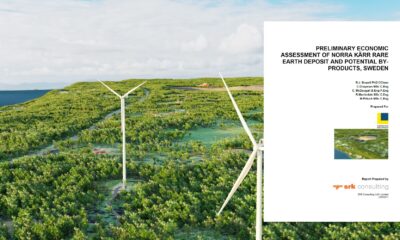Nyheter
David Hargreaves on oil, week 47 2013

Not the Yellow Metal, the Black One.
Regular readers of the Week in Mining will know that we champion a number of causes, run competitions and offer substantial prizes to the winners. Trillions of dollars actually. The fact that they are Zimbabwean is of no consequence. We have SOTBO (Statement of the Blinding Obvious), which draws regular contenders. Then ROOTS (the Running Out Of Things Society) and also SAC (the Society for the Abolition of Clichés). This latter has outlawed “the yellow metal” (gold), the “red metal” (copper) and now has its teeth into “black gold” or oil, as it is also known. There is no basis of comparison between the two, since oil is industrially useful and gold is not. It simply represents the fear factor.
Presently, a tonne of oil is worth less than an ounce of gold and this could – unthinkably – become less.
This is not because of a pending crash in the gold price but potentially in that of our favourite lubricant. It is much about the arrival of shale oil, particularly in the USA. That country, the single greatest world economic power house and energy user, was largely responsible for the Organisation of Petroleum Exporting Countries, OPEC, establishing a position of dominance in supply, ensuing that for 40 years the world price was at least quadruple its cost of production. That could abruptly end. America is about to become the largest producer once more, possibly an exporter. At least it will switch the focus onto growing importers China and India and could significantly alter the US perception of its role as the Middle East policeman. Our next step for oil is for marker Brent Crude, currently at $110 per barrel, to register $80, then welcome to no-man’s land. The trend is undeniable.
The trend is unmistakable: The USA is producing more oil and using less. This was a deliberate policy before shale gas came along. Thus its import dependency fell in the decade by 118Mt and is expected to zero in the next 2 to 3 years. Natural gas presents an even more startling picture. Production in the period has bounced over 26% and is gaining momentum. Consumption rose only 10% but in doing so, local prices have fallen sharply, from a peak of $8.85 per million BTU in 2008 to $2.76 by 2012. This has been at the expense of coal, where, as shown, production has fallen 9.5% and consumption 22.6%, leaving the country a growing net exporter. For the foreseeable future, this puts serious pressure on OPEC and particularly the Middle East. It could alter America’s defence attitude to the region, leading continuing importers China, Japan, India, EU in the hot seat. We might again start to call it black gold if those two commodities start to chase each other down the price spiral.
It has put the International Energy Agency, IEA, on a spot. Only this year, that watchdog described shale oil as a “game changer”. The Middle East producers who account for about 40% of world crude output and 60% of exports, have slowed down on new projects. Further, their sovereign wealth funds, Kuwait, Bahrain, UAE, Jordan, have been heavily investing abroad in non-oil businesses. Now the IEA is having a bit of a revisit. It thinks shale oil is now “Surge rather than a revolution” and East of Suez will reassert itself by the mid 2020’s. The same source now says the USA will overtake Russia as the largest producer in 2015 (it was to have been 2017). Reserves worldwide continue to grow, not least offshore Brazil, whilst stirrings in the automobile industry, as we report in Watchtower, are not to be ignored.
[hr]
About David Hargreaves
David Hargreaves is a mining engineer with over forty years of senior experience in the industry. After qualifying in coal mining he worked in the iron ore mines of Quebec and Northwest Ontario before diversifying into other bulk minerals including bauxite. He was Head of Research for stockbrokers James Capel in London from 1974 to 1977 and voted Mining Analyst of the year on three successive occasions.
Since forming his own metals broking and research company in 1977, he has successfully promoted and been a director of several public companies. He currently writes “The Week in Mining”, an incisive review of world mining events, for stockbrokers WH Ireland. David’s research pays particular attention to steel via the iron ore and coal supply industries. He is a Chartered Mining Engineer, Fellow of the Geological Society and the Institute of Mining, Minerals and Materials, and a Member of the Royal Institution. His textbook, “The World Index of Resources and Population” accurately predicted the exponential rise in demand for steel industry products.
Nyheter
Gruvbolaget Boliden överträffade analytikernas förväntningar

Gruvbolaget Boliden överträffade analytikernas förväntningar med bred marginal när man presenterade resultatet för det tredje kvartalet. Mikael Staffas, vd för Boliden, kommenterar kvartalet och hur han ser på råvarumarknaden och bolagets olika gruvprojekt.
Nyheter
Australien och USA investerar 8,5 miljarder USD för försörjningskedja av kritiska mineraler

USA:s president Donald Trump och Australiens premiärminister Anthony Albanese undertecknade på måndagen ett avtal som ska tillföra miljarder dollar till projekt inom kritiska mineraler.
Länderna kommer tillsammans att bidra med 1-3 miljarder dollar till projekten under de kommande sex månaderna. Den totala projektportföljen är värd 8,5 miljarder dollar, enligt regeringarna.
Galliumraffinaderi med kapacitet för 5x USA:s efterfrågan
Som en del av avtalet kommer det amerikanska försvarsdepartementet även att investera i ett galliumraffinaderi i västra Australien med en kapacitet på 100 ton per år. För närvarande importerar USA omkring 21 ton gallium, vilket motsvarar hela den inhemska konsumtionen, enligt den amerikanska geologiska myndigheten.
Initiativet kommer samtidigt som Kina har infört exportrestriktioner på vissa mineraler, däribland sällsynta jordartsmetaller, som är avgörande för tillverkningen av elektronik och elmotorer. Gallium används till exempel i mikrovågskretsar samt blå och violetta lysdioder (LED), vilka kan användas för att skapa kraftfulla lasrar.
Nyheter
Vad guldets uppgång egentligen betyder för världen

Guldpriset har nyligen nått rekordnivåer, över 4 000 dollar per uns. Denna uppgång är inte bara ett resultat av spekulation, utan speglar djupare förändringar i den globala ekonomin. Bloomberg analyserar hur detta hänger samman med minskad tillit till dollarn, geopolitisk oro och förändrade investeringsmönster.
Guldets roll som säker tillgång har stärkts i takt med att förtroendet för den amerikanska centralbanken minskat. Osäkerhet kring Federal Reserves oberoende, inflationens utveckling och USA:s ekonomiska stabilitet har fått investerare att söka alternativ till fiatvalutor. Donald Trumps handelskrig har också bidragit till att underminera dollarns status som global reservvaluta.
Samtidigt ökar den geopolitiska spänningen, särskilt mellan USA och Kina. Kapitalflykt från Kina, driven av oro för övertryckta valutor och instabilitet i det finansiella systemet, har lett till ökad efterfrågan på guld. Även kryptovalutor som bitcoin stiger i värde, vilket tyder på ett bredare skifte mot hårda tillgångar.
Bloomberg lyfter fram att derivatmarknaden för guld visar tecken på spekulativ överhettning. Positioneringsdata och avvikelser i terminskurvor tyder på att investerare roterar bort från aktier och obligationer till guld. ETF-flöden och CFTC-statistik bekräftar denna trend.
En annan aspekt är att de superrika nu köper upp alla tillgångsslag – aktier, fastigheter, statsobligationer och guld – vilket bryter mot traditionella investeringslogiker där vissa tillgångar fungerar som motvikt till andra. Detta tyder på att marknaden är ur balans och att kapitalfördelningen är skev.
Sammanfattningsvis är guldets prisrally ett tecken på en värld i ekonomisk omkalibrering. Det signalerar misstro mot fiatvalutor, oro för geopolitisk instabilitet och ett skifte i hur investerare ser på risk och trygghet.
-

 Nyheter3 veckor sedan
Nyheter3 veckor sedanGoldman Sachs höjer prognosen för guld, tror priset når 4900 USD
-

 Nyheter4 veckor sedan
Nyheter4 veckor sedanBlykalla och amerikanska Oklo inleder ett samarbete
-

 Nyheter3 veckor sedan
Nyheter3 veckor sedanGuld nära 4000 USD och silver 50 USD, därför kan de fortsätta stiga
-

 Nyheter2 veckor sedan
Nyheter2 veckor sedanLeading Edge Materials är på rätt plats i rätt tid
-

 Nyheter3 veckor sedan
Nyheter3 veckor sedanNytt prisrekord, guld stiger över 4000 USD
-

 Nyheter4 veckor sedan
Nyheter4 veckor sedanEtt samtal om guld, olja, koppar och stål
-

 Analys4 veckor sedan
Analys4 veckor sedanOPEC+ will likely unwind 500 kb/d of voluntary quotas in October. But a full unwind of 1.5 mb/d in one go could be in the cards
-

 Nyheter4 veckor sedan
Nyheter4 veckor sedanNeptune Energy bekräftar enorma litiumfyndigheter i Tyskland













